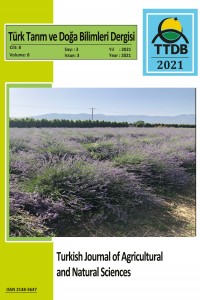Memeli Cinsiyet Hormonlarının in-vitro Şartlarda Bazı Hıyar (Cucumis sativus L.) Çeşitlerinin Rejenerasyonuna Etkisi
Abstract
Memeli cinsiyet hormonları (progesteron, estron, testesteron, androsterone, βestroidal ve 17β-estradiol) hem bitkilerde hem de hayvanlarda doğal olarak meydana gelen steroidal bileşiklerdir. Bu hormonlar bitkilerin üreme fonksiyonları ve metabolizmaları için oldukça önemlidir. Bu çalışmada Hasankale ve Gordiyon hıyar çeşitlerinin kotiledon yaprakları kullanılarak kallus geliştirme ve rejenerasyon ortamında 2,4D, estron ve testesteronun farklı kombinasyonları uygulanarak in-vitro şartları altında embriyogenik kallus oluşumu, sürgün gelişimi ve kök oluşumu üzerine olan etkileri araştırılmıştır. Hasankale çeşidinde 10-5mM Estrone, 10-6m MEestrone, 10-7mM Estrone, 10-5mM Testesteron, 10-6mM Testesteron uygulamaları hariç diğer bütün uygulamalar %100 kallus oluşuna neden olmuştur. Bununla beraber Gordiyon çeşidinde ise 2,4D, estrone ve testesteron kombinasyonlarının tamamında %100 kallus oluşumu meydana gelmiştir. Rejenerasyon ortamına aktarılan Hasankale çeşidinde en yüksek embriyogenik kallus ve sürgün oluşumu %93 ile 10-5mM Estrone, en yüksek kök oluşumu ise %60 ile 10-5mM Testesteron uygulamasında tespit edilmiştir. Gordiyon çeşidinde embriyogenik kallus oluşumu Hasankale çeşidine göre daha fazla olmuştur. Hem Estrone ve Testesteronun bireysel uygulamalarında hem de kombinasyonlarında %100’lük gelişim gözlenmiştir. Gordiyon çeşidinde en yüksek sürgün oluşumu %97 ile 10-7mM Estrone, en yüksek kök oluşumu ise %90 ile 10-7mM Testesterone uygulamalarında tespit edilmiştir. Sonuç olarak hıyar türünde kotiledon yapraklara memeli cinsiyet hormon uygulanmalarının embriyogenik kallus, sürgün ve kök oluşumu üzerine önemli katkı sağladığı gözlemlenmiştir.
References
- Aydoğdu, M., Boyraz N., 2005. Bitki büyüme düzenleyicileri (Hormon) ve hastalıklara dayanıklılık. Bitkisel AraĢtırma Dergisi, 1, 35-40
- Babaoğlu, M., Yorgancılar, M., Akbudak, M. A., 2001. Bölüm 1. Doku kültürü: Temel Laboratuvar Teknikleri. Bitki biyoteknolojisi I. Doku Kültürü ve Uygulamaları, Babaoğlu, M., Gürel, E., Özcan, S. S. Ü. Vakfı yayınları, Konya, Türkiye, 1-35.
- Bajguz A., Czerpak R. 1996. Metabolic activity of estradiol in Chlorella vulgaris Beijerinck (Chlorophytaceae) Part 1. Content of photosynthetic pigments. Pol Arch Hydrobiol 43: 421-426
- Bajguz A., Czerpak R. 2000. Metabolic activity of estradiol in Chlorella vulgaris Beijerinck (Chlorophytaceae) Part 2. Content of the cellular sugar and protein accumulation. Pol Arch Hydrobiol 43: 427-430.
- Barrington, E.J.W. (1979). in: Hormones and Evolution (E.J.W. Barrington, ed.) (pp. VII-XXI). London, Academic Press. Bhattacharya B., Gupta K. 1981. Steroid hormone effects on growth and apical dominance of sunflower. Phytochemistry 20: 989-991
- Bonner J., Axtman G. 1937. The growth of plant embryos in vitro. Preliminary experiments on the role of accessory substances. Proc Natl Acad Sci USA 23: 453-457
- Chouard, P.(1937). Action combinee de la falliculine et la duree declairement sur la floraison des Reines-Marguerites. C.R.Acad.Sci.Paris,B,126,509.
- Czygan J.C. 1962. Blütenbildung bei Lemna minor nach Zusatz von Oestrogen. Naturwissenschaften 49: 285-286 Gawienowski M., Cheney R.W., Marsh H.V. 1971. Alteration ofsex expression in the cucumber by testosterone and estradiol. Phytochemistry 10: 2033-2034.
- Geuns, J. M. C. (1978) Steroid hormones and plant growth and development. Phytochem. 17, 1–14. Güleryüz, M., 1982. Bahçe Ziraatinde Büyütücü ve Engelleyici Maddelerin Kullanılması ve Önemi (Heinz Jansen’den tercüme). Atatürk Üniv. Yay. No.599 Erzurum 130 s
- Guan M., Roddick J.G. 1988a. Comparision of the effects of epibrassinolide and steroidal estrogens on adventitious root growth and early shoot development in mung bean cuttings. Physiol Plant 73: 426-431
- Guan M., Roddick J.G., 1988b. Epibrassinolide - inhibition of development of excised, adventitious and intact root of tomato (Lycopersicon esculentum): comparison with the effects of steroidal estrogens. Physiol Plant 74: 720-726.
- Helmkamp G, Bonner J (1952) Some relationships of sterols to plant growth. Plant Physiol 28: 428-436
- İslam T. (2014). Department of Biotechnology, Bangabandhu Sheikh Mujibur Rahman Agricultural University, Gazipur-1706, Bangladesh
- Janeczko A. (2000) Influence of selected steroids on plant physiological processes - especially flowering induction (in Polish). PhD Dissertation, Agricultural University, Krakow, Poland
- Janeczko Z, Szybka P (2001) Induction and proliferation of callus of Polygonatum verticillatum L (in Polish). Conference materials of the 18th Meeting of the Polish Pharmaceutical Society "Pharmacy in the 21st century". Poznan, Poland, p 536
- Janeczko A., Filek W., Janeczko Z. 2003. Proliferation of Arabidopsis thaliana callus on medium containing 4-androstene-3,17-dione, 2,4-dichlorophenoxyacetic acid and benzylaminopurine (in Polish). Materials of conference "Biotechnology in biology, pharmacy and agriculture" 15-17 September 2003, Bydgoszcz, Poland, p 121
- Janeczko A, Skoczowski A (2005) Mammalian sex hormones in plants. Folıa hıstochemica et cytobıologıca 43: 71-79 Janeczko, A. 2012, Steroids, 77, 169-173.
- Kılıç, Y., 2007. Fitohormonların Saplı MeĢe (Quercus robur L.) 1+0 YaĢlı Fidan Morfolojik Karakterler Üzerine Etkisi.Y. Lisans Tezi, Gazi Üniversitesi Fen Bilimleri Enstitüsü, Ankara
- Kopcewicz J. 1969. Influence of estrone on growth and endogenous giberellins content in dwarf pea. Bull Sci C1.II, Vol. XVII, No 11-12
- Kopcewicz J. 1971. Influence of steroidal hormones on flower sex expression in Ecballium elaterium (L.). Z Pflanzenphysiol 65: 92-94
- Kumlay, A.M., Eryiğit, T., 2011. Bitkilerde büyüme ve geliĢmeyi düzenleyici maddeler: Bitki hormonları. Iğdır Üni. Fen Bilimleri Enst. Der. 1(2), 47-56.
- Löve A, Löve D (1945) Experiments on the effects of animal sex hormones on dioecious plants. Ark Botanik 32A, No 15:1-60 Milanesi, L., Boland, R., 2004. Presence of estrogen receptor (ER)-like proteins and endogenous ligands for ER in solanaceae. Plant Science, 166, 397-404.
- Sandor, T. and Mehdi, A.Z. (1979) in: Hormones and Evolution (E.J.W. Barrington, ed.) pp. l-72, Academic Press, London Sarin, R., 2005. Useful metabolites from plant tissue cultures. Biotechnology, 4(2), 79-93.
- Simons, R.G., Grinwich, D.L., 1989. Immunoreactive detection of four mammalian steroids in plants. Can J Bot 67: 288-296. Speranza, A., 2010.Into the world of steroids: A biochemical “keep in touch” in plants and animals.Plant Signaling and Behavior, 5(8), 940-943
Details
| Primary Language | Turkish |
|---|---|
| Journal Section | Research Articles |
| Authors | |
| Publication Date | July 26, 2021 |
| Submission Date | December 24, 2020 |
| Published in Issue | Year 2021 Volume: 8 Issue: 3 |

